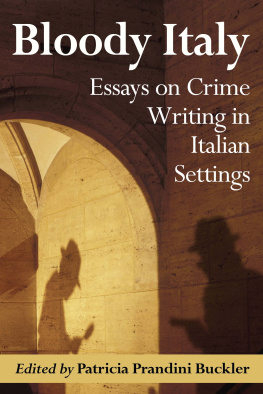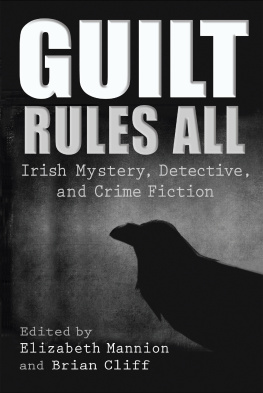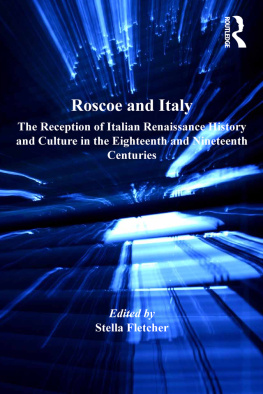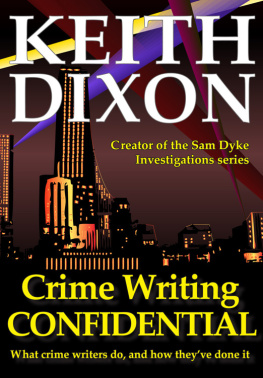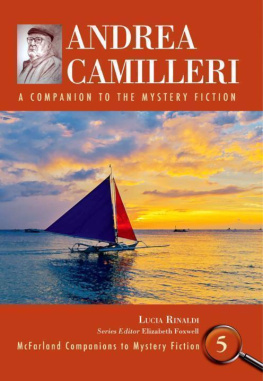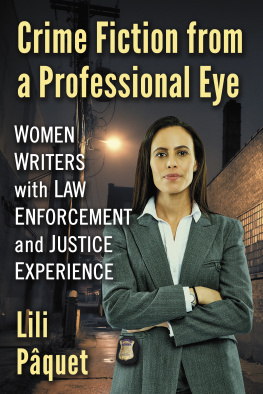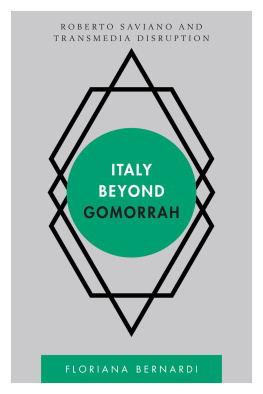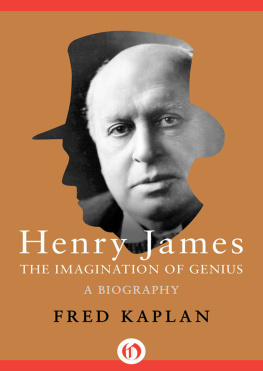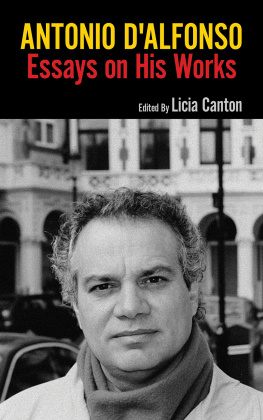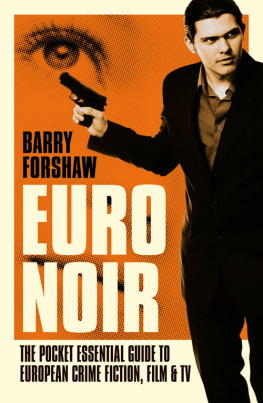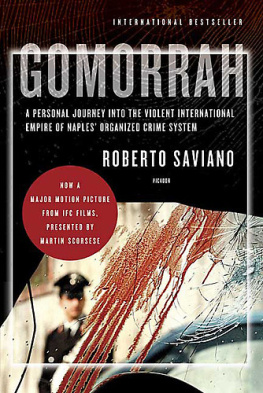
Bloody Italy
Essays on Crime Writing in Italian Settings
Edited by Patricia Prandini Buckler

McFarland & Company, Inc., Publishers
Jefferson, North Carolina
LIBRARY OF CONGRESS CATALOGUING DATA ARE AVAILABLE
BRITISH LIBRARY CATALOGUING DATA ARE AVAILABLE
e-ISBN: 978-1-4766-1469-4
2014 Patricia Prandini Buckler. All rights reserved
No part of this book may be reproduced or transmitted in any form or by any means, electronic or mechanical, including photocopying or recording, or by any information storage and retrieval system, without permission in writing from the publisher.
Cover illustration iStockphoto/Thinkstock
McFarland & Company, Inc., Publishers
Box 611, Jefferson, North Carolina 28640
www.mcfarlandpub.com
To Warren, of course
Preface
As crime writing has become more popular and titles have become more numerous, scholars have begun to recognize the value of the genre not only to readers but also for the serious study of literature in the university. Detective fiction and true crime writing have both become locations for the exploration of cultural norms and values, and critical works explore the nature of the genre as well as its insights into society. Although still vastly significant, British, French, and American authors have been joined by important writers from counties as different as China, Japan, Israel, Sweden, Germany, and Italy.
In the latter twentieth and early twenty-first century, native Italian detective series have become more available in translation, and more series written in English and set in Italy have emerged. Italy is a popular setting for crime writing because of its historical importance, sunny climate, beautiful art and landscapes, high fashion, fast cars, and its idiosyncratic justice system.
Significantly, fiction and non-fiction works both reveal a consistent and troubling dysfunction in the Italian justice system as well as in other areas of public life. Corruption at all levels of power shows through. Observers around the world have been galvanized by accounts of the traditional criminal clan structure of the mafia and the Camorra on the one hand, and on the other hand, the criminal activity of elected officials and sensational individual murder cases. Italian true crime stories or cronaca expose a slimy underbelly of corruption that reaches all the way to the top echelons of officialdom, besmirching even prime ministers and their cabinets. And peculiar to Italy, novelists have blended actual police records, transcripts, and legal investigations with the imaginative shaping of their fictional narratives. These stories all show a system wherein the democratic goal of finding justice through the rule of law is thwarted. The bad guys seem to be winning, and the good guys seem to achieve positive outcomes only through personal moral compromise.
At the start, my contributors and I wanted to examine more closely the works of Italian crime writing available to English-language readers, showing ways that they tackled concerns in common with the larger world, especially the United States and Great Britain. We didnt set out to write a book that demonstrated the inefficacy of Italian law, but most of the contributors unwittingly struck the same chords of alarm. What we discovered was that the overwhelming concern of both fiction and non-fiction authors was the shocking erosion of mainstream Italian civil and moral principles. Crime writers universally portray an Italy where truth, honesty, integrity, and morality have teetered well beyond the edge of collapse. The sweet landscapes under the Italian sun are quite different when viewed through the nighttime shadows of corruption and despair.
Introduction
As in many other countries, detective fiction in Italy began as American, English and French detective fiction in translation, with Poe, Conan Doyle, and Gaboriau among the favorites. An Italian parody of Sherlock Holmes, Shairlock Holmes in Italia, appeared as early as 1902. In 1929 the Mondadori publishing company began its series of foreign detective novels in translation, calling the series I Giallo. Eventually, giallo became the generic term. The first serious efforts to produce uniquely Italian detective fiction occurred in the late 1920s with the publication in 1928 of Robin, agente secreto by Augusto DeAngelis. DeAngelis was most productive between 1935 and 1943, publishing fifteen detective novels. With the advent of Fascism in the 1930s and 1940s, the genre was suppressed, and Mondadori ceased publishing detective novels between 1941 and 1948. After the war, foreign detective stories in translation were most popular until the 1970s, when an Italian detective genre began to emerge once again.
Italian detective writers have undertaken a large variety of types of detective fiction and non-fiction. They have successfully used a variety of settings from rural to urban, from ancient Rome to modern Italy. Although this volume primarily focuses on Italian crime writing available to an English-language readership, including books written by British or American authors, the mystery today is a broadly appreciated international genre. Looking at developments in the Italian variety of the mystery genre shows the symbiosis among Italian, English, American, and European authors in the evolution of the crime story.
This study focuses on specific topics and authors that are of interest to readers of mysteries in Italian settings.
The collection begins with my own essay on the Italian detective novel as it developed in line with the classic American and British model, but then took its own path. It follows the changes in Italian detective writing from the creation of the yellow book series by Mondadori in 1929, through the Fascist era, the years of lead, and into the present.
Next, Nicole Welgens essay addresses the question of the so-called misteri dItalia, dozens of assassinations and attacks, mostly political in nature, whose perpetrators have never been identified. They occurred from the end of the 1960s to the beginning of the 1980s. The period is known as the years of lead, due to the vast number of bullets fired. Fiction on the years of lead is booming in Italy. At least one murder is committed in each novel, but that does not necessarily qualify them as mystery novels, or does it? This question is discussed on the basis of three recent novels taking very different approaches to this eventful chapter of Italys post-war history.
Alice Bendinelli then turns to non-fiction crime writing, discussing specifically Roberto Savianos Gomorrah: A Personal Journey Into the Violent International Empire of Naples Organized Crime System, a highly successful and controversial work that features the criminal organization based in Naples, the Camorra. Styled by the author as a non-fiction novel, the book blurs any distinction between literary genres, fiction and non-fiction, and becomes a hybrid form generated at the crossroads of journalistic reportage, fictional imagination, diaristic accounts and confessions; it is a work that some critics have defined as UNO (unidentified narrative object). The essay deals with the novel itself, and with the reaction to the novel among the media and by the Camorra families.
In the hills around Florence, fourteen young lovers were murdered and mutilated between 1974 and 1985. This serial murderer has become the focus of numerous books and articles, as well as documentaries, TV shows, comic books, movies, and docu-dramas. My next essay focuses on books written by Italian mystery novelist Laura Grimaldi; by Magdalen Nabb, a British expatriate whose series hero is a detective of the carabinieri, Marshal Salva Guarnaccia of Florence; and by American mystery writer Douglas Preston, who teamed up with Italian journalist Mario Spezi to produce a true narrative of the hunt for the Monster. In these three creative re-examinations of the Monster case, the reactions of the public become as important as the murders themselves.
Next page
